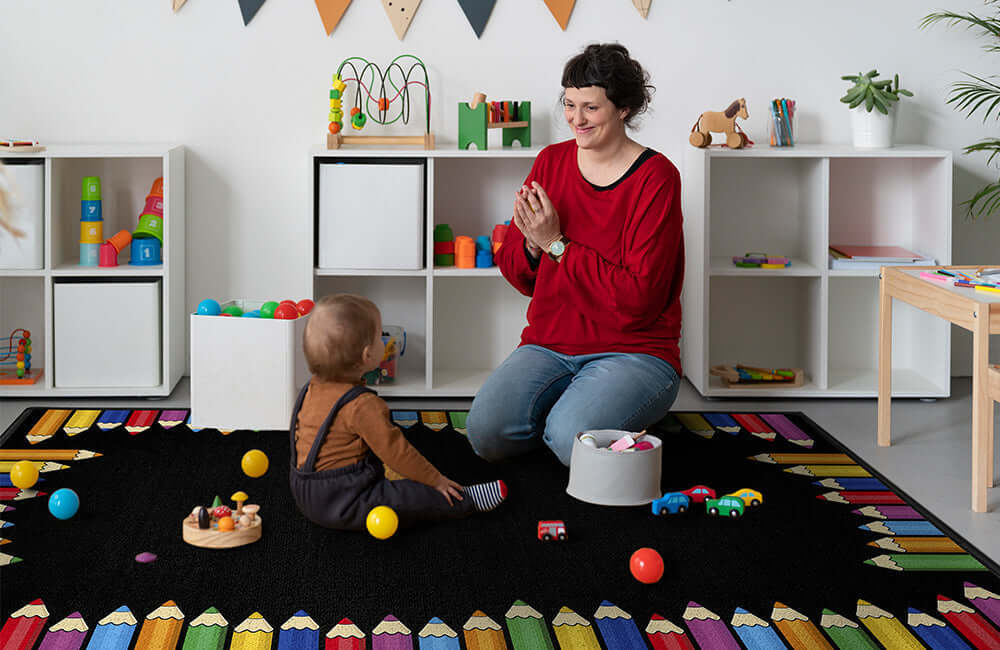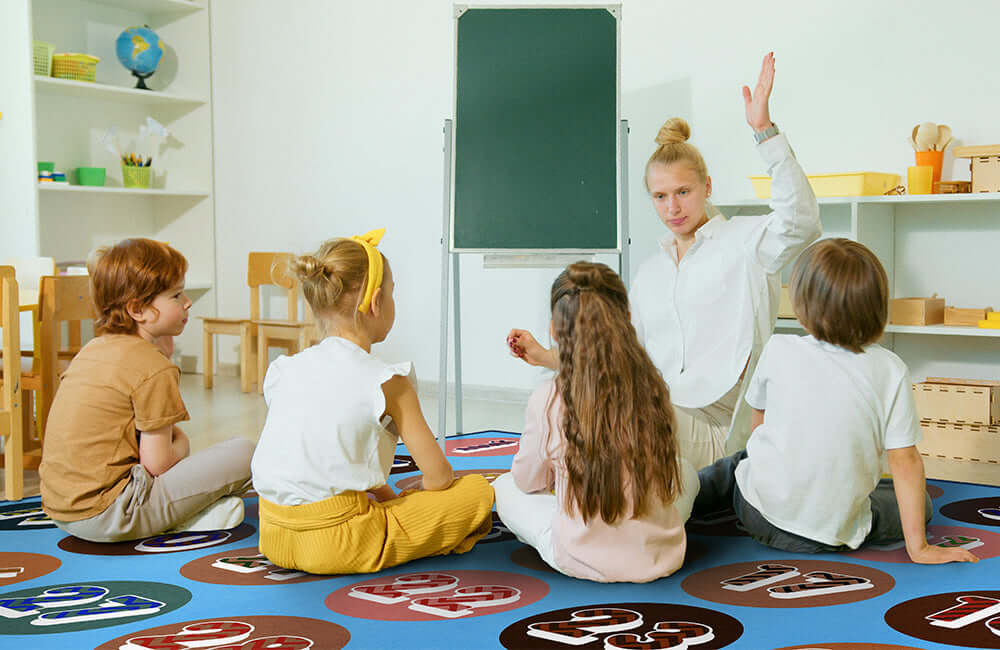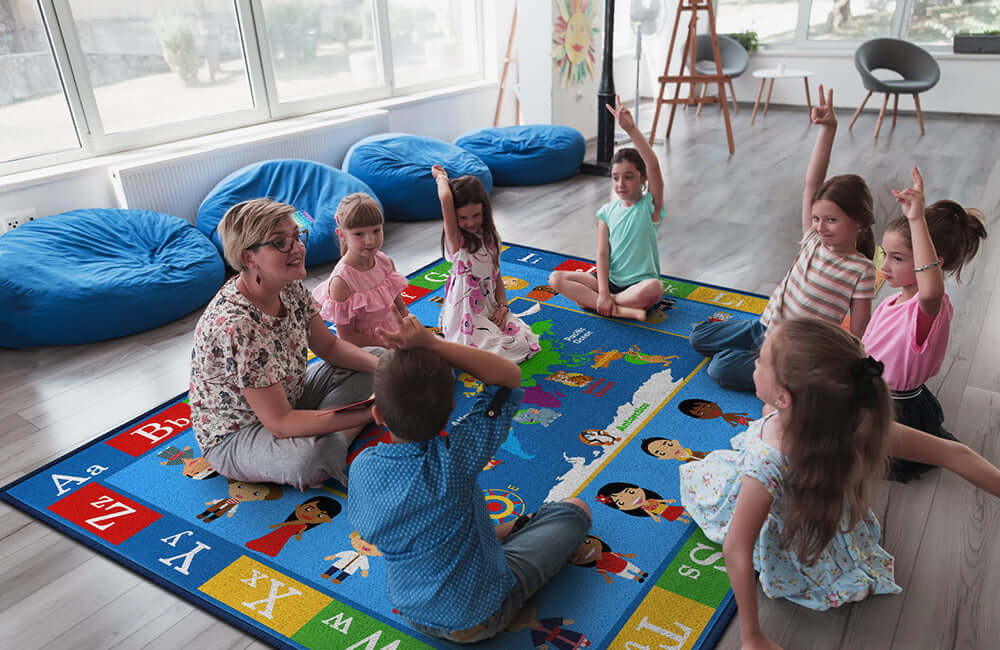In today's educational landscape, teaching academics is just one piece of the puzzle.
Increasingly, educators recognize that supporting students' social-emotional development is equally crucial for long-term success and wellbeing.
One powerful yet often overlooked tool in this endeavor is the strategic use of dedicated classroom rugs—areas that can become the heart of social-emotional learning (SEL) in your classroom.
These purposefully designed soft spaces, often anchored by comfortable classroom seating rugs, offer more than just a seating alternative; they provide a dedicated zone where students can develop emotional awareness, practice mindfulness, build community, and learn crucial self-regulation skills.
When thoughtfully implemented, carpet areas become physical anchors for the abstract work of social-emotional learning—creating literal and figurative "safe spaces" where students can grow in ways that extend far beyond academic achievement.
The SEL-Environment Connection
Research consistently demonstrates that physical environments significantly impact social-emotional development.
According to Edutopia's research on learning spaces, the physical arrangement of a classroom can either support or hinder students' emotional regulation and social interactions.
The connection happens on multiple levels:
Neurological Impacts
Comfortable, defined spaces help activate the parasympathetic nervous system—our "rest and digest" mode—making it physiologically easier for students to:
- Regulate emotions
- Focus attention
- Process social information
- Engage in reflection
Psychological Safety
Dedicated comfort spaces signal to students that their emotional wellbeing matters.
As noted in CASEL's framework for SEL implementation, creating environments where students feel safe, seen, and supported is foundational to effective social-emotional learning.
Community Building
Shared gathering spaces naturally facilitate connections between students.
The physical arrangement of sitting on dedicated circle time rugs promotes equality and focused interaction:
- Eye contact
- Equal participation
- Sense of belonging
- Collective identity
For more resources on how classroom environments affect student wellbeing, visit our article on trauma-informed classroom design.
Designing Effective Carpet Spaces for SEL
Creating carpet spaces that truly support social-emotional learning requires intentional design:
Location Considerations
- Visual privacy: Positioned where students feel some separation from high-traffic areas
- Acoustic properties: Away from noisy zones or equipment
- Accessibility: Easily reached by all students, including those with mobility considerations
- Teacher visibility: Within line of sight for appropriate supervision
Size Guidelines
- Whole-class gatherings: Use large classroom rugs (10' × 12' minimum) to comfortably seat 20-25 students for morning meetings
- Small group zones: 6' × 8' accommodates 6-8 students
- Individual reflection spots: Smaller mats or reading rugs (3' × 5') provide personal space for one student to decompress.
Shape Selection
- Circular rugs: Promote equality and inclusion in discussions
- Rectangular rugs: Offer clear organization for structured activities
- Irregular shapes: Can define unique "special" spaces for specific SEL purposes
For detailed information on rug selection and placement, see our comprehensive guide on classroom rug dimensions.
Essential Elements of SEL Carpet Areas
Effective SEL carpet spaces typically incorporate several key components:
Visual Supports
- Emotion charts: Displayed nearby to help students identify and discuss feelings
- Calming imagery: Nature scenes or the soft tones found in our pastel classroom rugs that promote relaxation and lower sensory overload
- Affirmation posters: Positive messaging that reinforces SEL concepts
Comfort Elements
- Pillows or cushions: Providing both physical comfort and grounding weight
- Weighted blankets: Offering sensory regulation support
- Back supports: Ensuring students can maintain comfortable posture during longer gatherings
Organizational Tools
- Storage for SEL materials: Easily accessible containers for mindfulness tools
- Visual boundaries: Clear markings for personal space when needed
- Meeting tools: Talking pieces, timers, or other discussion facilitators
According to MindShift, these physical supports don't just enhance the space—they actively communicate values and expectations about emotional expression and regulation.
Mindfulness Activities for Carpet Gatherings
The carpet area becomes particularly powerful when used for dedicated mindfulness practices that support SEL goals:
Breathing Exercises
- Flower breathing: Inhaling as if smelling a flower, exhaling slowly
- Five-finger breathing: Tracing fingers while breathing in and out
- Bubble breathing: Visualizing bubbles floating away with each exhale
Embodied Awareness Activities
- Body scan: Systematically noticing sensations from toes to head
- Progressive muscle relaxation: Tensing and releasing muscle groups
- Mindful movement: Gentle stretches or yoga poses appropriate for the space
Emotional Literacy Practices
- Feeling check-ins: Using the carpet circle for emotional temperature checks
- Story-based discussions: Exploring emotions through literature
- Emotion coaching conversations: Guided discussions about emotional responses
For ready-to-use mindfulness scripts specifically designed for carpet gatherings, visit our resource on classroom mindfulness activities.
Age-Appropriate Adaptations
SEL carpet spaces should evolve to meet the developmental needs of different age groups:
Early Childhood (PreK-K)
- Physical setup: Clear individual spots marked on the rug
- Activities focus: Concrete emotion identification, simple calming techniques
- Visual supports: Picture-based emotion cards, simple breathing visuals
- Time considerations: Brief 5-7 minute gatherings multiple times daily
Elementary (Grades 1-5)
- Physical setup: Flexible seating options around defined carpet areas
- Activities focus: Connecting feelings with behaviors, conflict resolution
- Visual supports: Emotion vocabulary charts, strategy reminders
- Time considerations: 10-15 minute dedicated SEL sessions plus as-needed
Middle School and Beyond
- Physical setup: More mature comfort spaces featuring boho classroom rugs that feel less "childish" and more like a lounge
- Activities focus: Complex emotional awareness, stress management
- Visual supports: Reflection prompts, mindfulness reminders
- Time considerations: Schedule regular check-ins plus student-initiated use
According to Greater Good Magazine, age-appropriate SEL spaces help students develop agency and emotional competence aligned with their developmental stage.
Supporting Diverse Needs
Effective SEL carpet spaces must be designed with all learners in mind:
Sensory Considerations
- Texture variety: Different carpet textures for sensory-seeking students
- Lighting options: Ability to adjust brightness for sensory-sensitive learners
- Sound management: Acoustic properties that minimize overwhelming noise
Trauma-Informed Approaches
- Predictable routines: Clear expectations for carpet space usage
- Choice provisions: Options to participate while maintaining personal boundaries
- Safety features: Positioning that allows students to see the door and teacher
Cultural Responsiveness
- Inclusive imagery: Diverse representation in any visual elements
- Multiple expressions: Honoring culturally different ways of showing emotions
- Community input: Involving students in creating meaningful shared spaces
Wikipedia's article on Social-Emotional Learning notes that effective SEL must be culturally responsive and inclusive to achieve equitable outcomes.
Teacher Testimonials
Educators who have implemented dedicated SEL carpet spaces report significant benefits:
"Our morning carpet circles completely transformed our classroom community. The physical act of gathering in a defined, comfortable space signals to students that we're switching into a different, more reflective mode. I've seen remarkable growth in their ability to express emotions and listen to peers." — Ms. Rivera, 3rd Grade Teacher
"For my middle schoolers, I created what we call 'The Reflection Nook'—a carpeted area with more mature cushions and mindfulness tools. What surprised me was how quickly they took ownership of the space, establishing their own norms and using it responsibly during independent work time for emotional regulation." — Mr. Jackson, 7th Grade Advisory Teacher
Implementation Challenges and Solutions
Creating effective SEL carpet spaces isn't without challenges. Here are common issues and practical solutions:
Space Limitations
Challenge: Insufficient floor space for dedicated carpet areas Solutions:
- Use modular pieces that can be arranged as needed and stored when not in use
- Create multi-purpose spaces that serve academic and SEL functions
- Implement vertical separation (room dividers) to create psychological boundaries
Budget Constraints
Challenge: Limited funds for quality carpets and comfort elements Solutions:
- Start small with one high-quality anchor piece
- Seek donations from local businesses or parent organizations
- Explore DonorsChoose and similar education funding platforms
Maintenance Concerns
Challenge: Keeping soft surfaces clean and hygienic Solutions:
- Establish clear usage expectations with students
- Implement regular cleaning schedules
- Choose washable materials when possible
According to Cult of Pedagogy, starting small and evolving your classroom design over time is often more successful than attempting a complete transformation at once.
Conclusion
Dedicated carpet spaces represent far more than decorative classroom elements—they are powerful tools for creating environments where social-emotional learning can flourish.
By thoughtfully designing these areas with SEL principles in mind, educators create physical anchors for the important work of developing emotional intelligence, mindfulness practices, and community connections.
As you consider implementing or enhancing SEL carpet spaces in your own educational setting, remember that the physical environment and emotional learning are intrinsically connected.
The time and attention devoted to creating these special areas signals to students that their emotional wellbeing matters—a message that reverberates far beyond the classroom walls.
From morning meetings to mindfulness moments, from conflict resolution to celebration circles, your carpet space can become the heart of a classroom community where students learn not just to succeed academically, but to thrive emotionally and socially as well.




Leave a comment
This site is protected by hCaptcha and the hCaptcha Privacy Policy and Terms of Service apply.